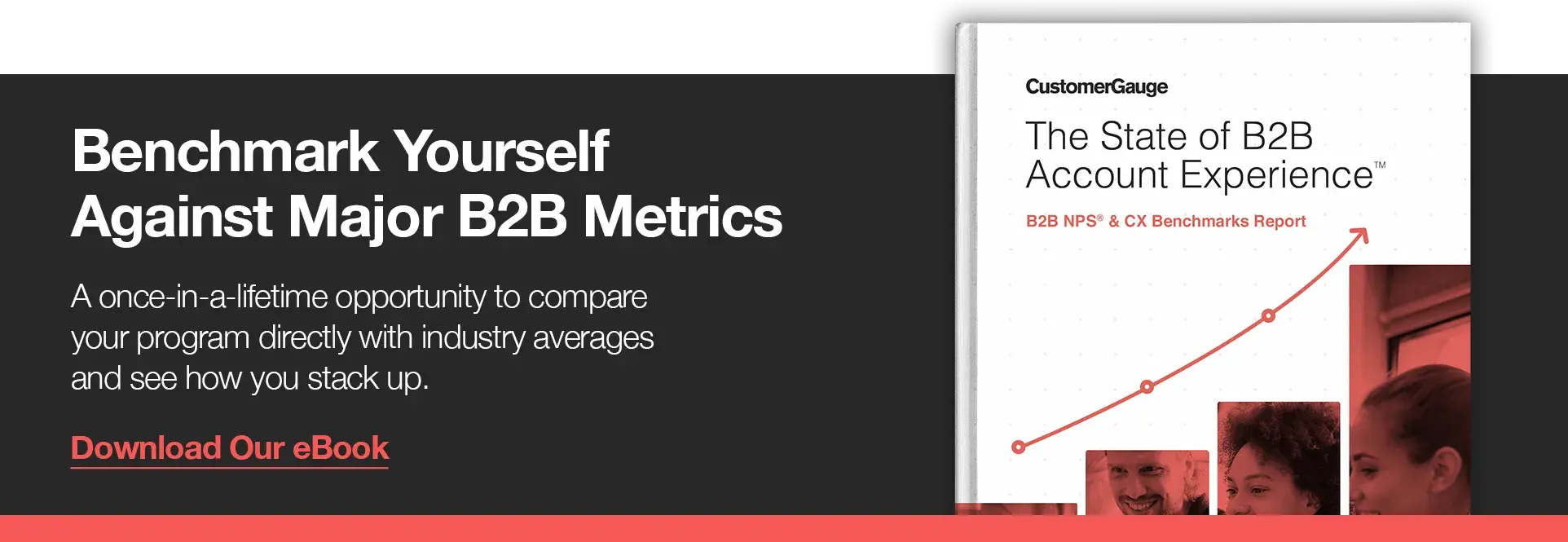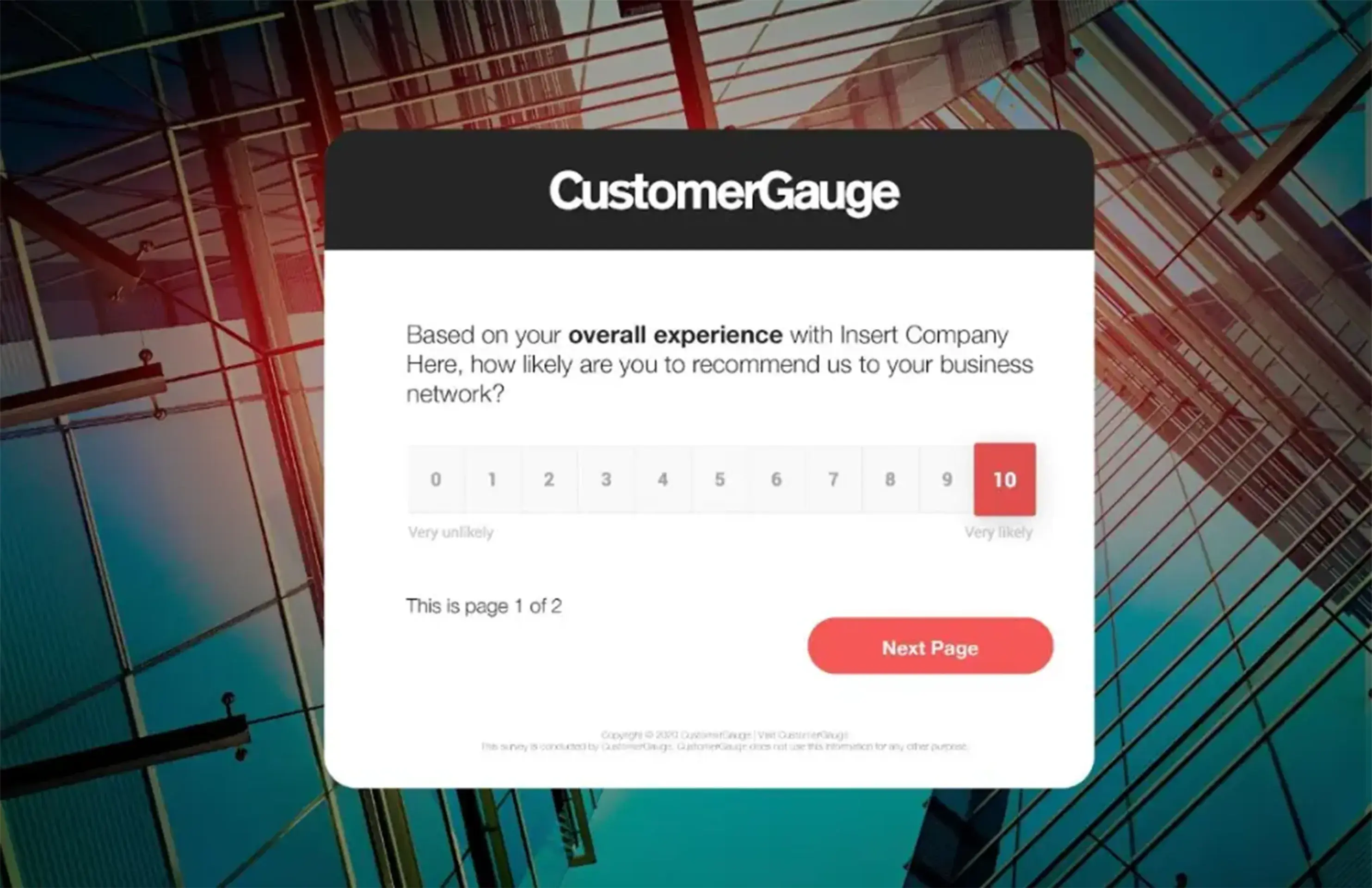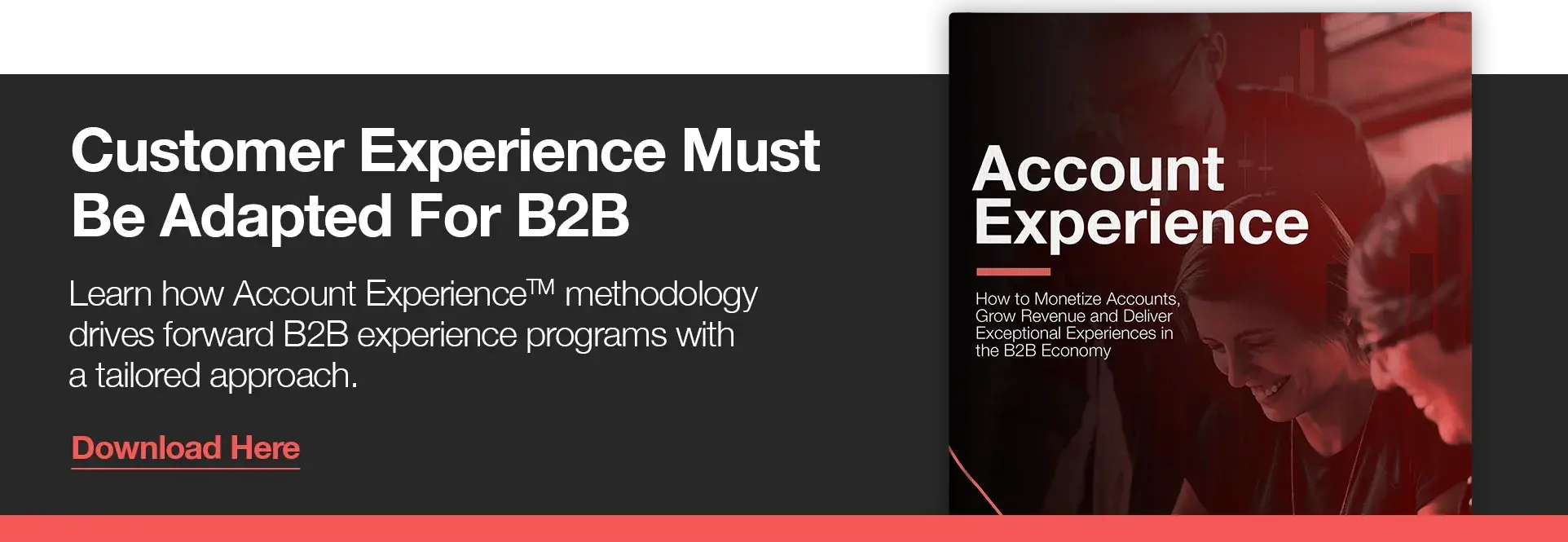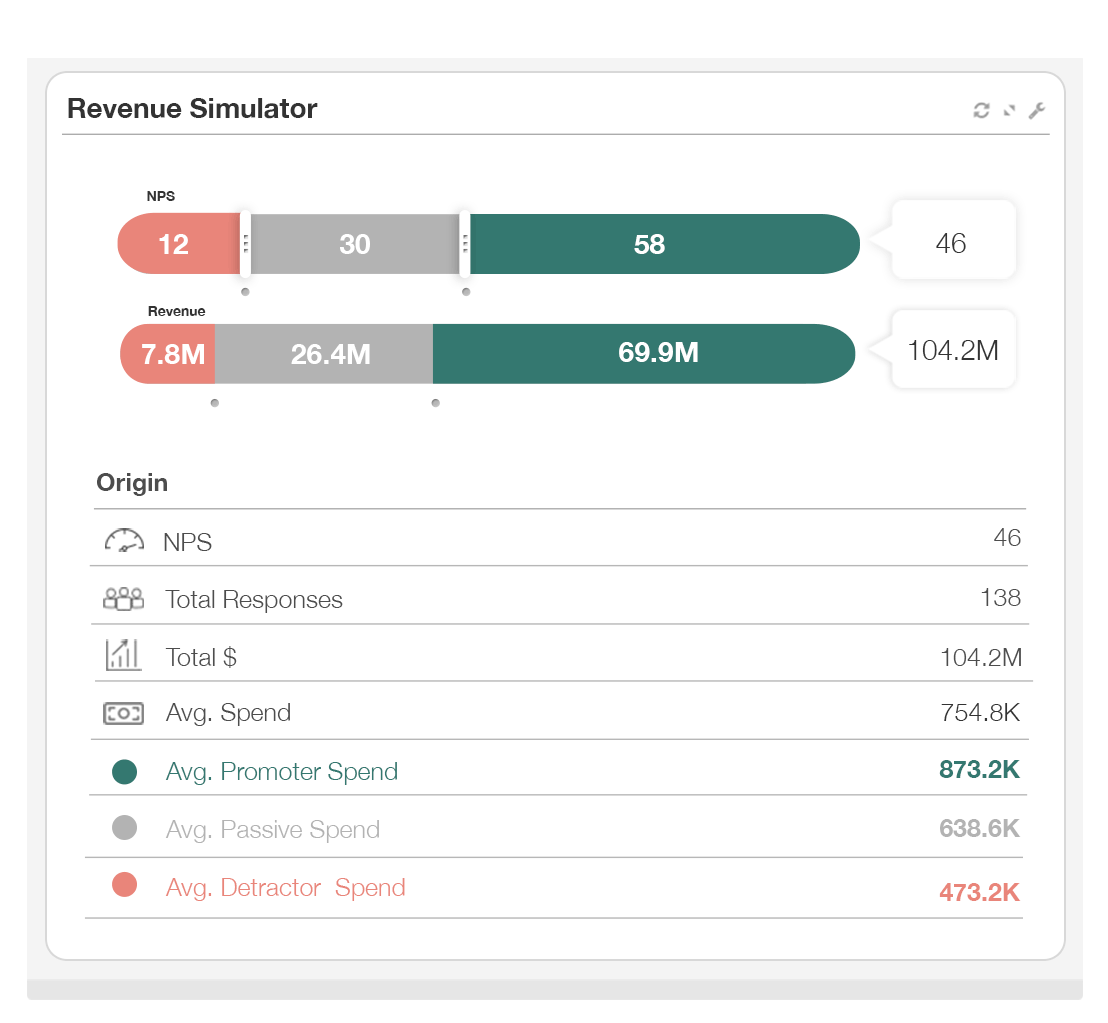You may have heard of the Net Promoter Score (NPS), the widely-used metric for gauging your customer experience (CX).
However, let’s be real: a metric alone isn’t enough to make the CX transformations that improve retention and create customer champions. In fact, many companies get caught up in the vanity project of improving their NPS score—something that can be easy to manipulate.
Rather than devoting yourself just to a particular number, a program for action that is supported by feedback, is what will really drive new growth.
Enter the Net Promoter System.
Invented by Bain & Company, the NPS System is designed to help brands turn their NPS Score into action toward growth. And in this article, we’re going to show you how to reap its rewards.

Download 1,000s of company scores here.
What is the Net Promoter System? A Brief History of the Other NPS

Let’s be honest. The NPS acronym can be a little confusing. The ‘S’ can stand for either “Score” or “System,” and to understand one, you need to know the other. So, let’s run it back.
In 2003, Fred Reichheld (of Bain & Company) introduced the world to the Net Promoter Score metric in his book The Ultimate Question: Driving Good Profits and True Growth.
The ultimate question was a simple one: How likely are you to recommend our company to a friend or colleague? Respondents would answer by choosing a number on a scale of 0 to 10 (0 being “not at all likely” and 10 being “extremely likely”).
Anyone answering 0-6 is considered a “detractor”, your least enthusiastic customer. Those answering 7 or 8 are “passive” (not likely to bad mouth your business, but also at risk of churning to a competitor). And those scoring 9 or 10 are your “promoters”—your most loyal customers, spreading positive word of mouth.
Once you have your survey results, working out the NPS score is simple:
It’s the % of promoters - % detractors.
For example, if you have 50% promoters and 20% detractors, your Net Promoter Score would be 30.
Read more: What is a Good Net Promoter Score (NPS)?
A Customer Loyalty Metric Alone Is Not Enough
The next step from the score itself was the follow up questions. Reichheld and co. soon realized that to make the NPS score truly meaningful, there had to be some context attached. So they tagged on an additional question: “Why?”
Why did the customer choose that particular rating?
Asking customers to tell you in their own words helps you understand what sort of action is required to improve their experience.
However, collecting feedback and insights alone is not enough—companies weren’t able to put it to good use in an easy way. In order to go from the NPS calculation to customer experience program, there had to be a playbook everyone could follow as well.
“The System builds on the Score and requires every level of the organization to be rigorously, consistently focused on the quality of customer and employee relationships first. Installing the Net Promoter System requires a strategic commitment by company leadership because it defines cultural values and core economics that affect every part of the business system.”—Bain & Co
Compared to the Net Promoter Score, which measures customer loyalty, the System offers a practical methodology to leverage the collected feedback to improve internal processes and relationships with customers.
Hence, the Net Promoter System was born.
What are the Benefits of the Net Promoter System®?
The clear benefit of following the Net Promoter System is that it gives you a highly actionable method to improve customer loyalty.
Loyal customers typically stay longer, buy more, are cheaper to serve, refer your brand to others, speak positively about you on social media, and perhaps even help you produce and launch new products.
However, by slavishly devoting themselves to the NPS Score alone—rather than to a program of action—many companies weren’t achieving those benefits. But that’s the problem the System was designed to solve.
Now you know what it is and why it matters, how can you implement your own Net Promoter System?
How to Build Your Own Net Promoter System®
As you set out to establish your Net Promoter System, you will have a number of tasks to focus on. To make things easier, we’ve broken everything down across 4 stages.
Setting Up Your Net Promoter System
Building on the Foundations of Your NPS System
Creating the Conditions for Growth
Growth
Each stage has several vital steps to follow. Let’s get started.
Setting Up Your Net Promoter System
In this period, you should start to survey your customers. You’ll get your first feedback and a sense of the issues that you need to engage with.
At this point, the survey you use will be the relationship survey, which gives you the ‘real’ Net Promoter Score (i.e. the score that tells you your customers' overall experience with your brand). Only later will you start to use the type of NPS survey, the transactional survey.
Here’s what to do to get started as an executive.
Step 1. Assign Your NPS Program Manager
Every successful program needs a good manager, and your NPS System is no different. Best practice is to identify a respected senior employee or a manager with a good internal network and change management skills. Those skills will come in handy later.
If your company already has a customer experience manager, that could be your NPS program manager.
Step 2. Empower the Program Manager
Empower your program manager with training and a Net Promoter tool. Both come at very reasonable prices when you start with just a single survey.
Give the program manager access to customer data and permission to send surveys. This seems like an easy step, but make it clear within your organization that your company will begin sending surveys. Some of your workforces will feel ownership towards their customers and want to know everything that the company communicates to them. And lack of communication creates resistance throughout your organization, meaning you will be off to a bad start.
If you already do a yearly customer satisfaction survey, then let your organization know that you will do a similar survey but with fewer questions.
Step 3. Approve the NPS Survey
Before your program manager sends the first survey, you as the executive should approve it. If constructed correctly, it should provide you with a Net Promoter Score question and information about the touchpoints in your customer journey and how they contribute to the score.
If you dislike the survey, you’ll probably not use the data to make the necessary decisions at the next level. So, it’s important that you know what it contains before you start.

Step 4. Check the Health of Your Customer Experience
Once your program manager has set up and executed your first NPS survey, discuss the results. What is your Net Promoter Score? What responses did you get? And what are the reasons for detraction, passiveness, and promotion?
You will most likely learn things about your company you didn’t know. But that’s why you are launching your NPS System in the first place.
Building on the Foundations of Your Net Promoter System
Getting the Net Promoter System up and running takes roughly a month for every additional touchpoint that you wish to monitor. Usually, the whole system is operational in 3-4 months.
In this case, though, the last part of an operational system is setting and tracking targets. This means that this stage typically takes 6-12 months.
Here’s what you need to do.
Step 5. Approve the CX Management Roadmap
The customer survey from stage 1 will tell you which touchpoints in the customer journey you also need to survey. For instance, if a high-volume transaction like customer support creates a lot of detraction, the support organization may benefit from surveying each support incident. Asking how satisfied the customer is with the support they receive will help the support organization learn what they do right and wrong.
This is where you will need to take more specific NPS surveys—the transactional surveys. These can help you understand customer sentiment around a specific touchpoint or interaction. Find out more about these here: Relational vs Transactional NPS Surveys
Get your program manager (and solution provider) to plan for additional touch points, including a rollout of tools and processes, and training of relevant employees. Then, approve the plan and communicate it to the organization.
Step 6. Get Buy-In from Senior Management
Use the results from your first survey to establish buy-in with your senior management. Their support is crucial to enable you to roll out the Net Promoter System.
By the way, in our annual NPS industry survey, we asked over 600 companies using NPS “What was the top contributor of success?” You guessed it, “good executive buy-in” topped the list!
Download 1,000s of company scores here.
Step 7. Identify Net Promoter Champions
A Net Promoter program is a change exercise. People will carry out new activities and later change their way of working to better deliver value to customers. Irrespective of how much sense customer centricity and NPS makes, change fosters resistance. And as an executive, it is your role to help your organization get through it.
To mitigate this, ask senior management to help the program manager find Net Promoter Champions—typically senior employees from every relevant unit. The task of the Net Promoter Champions is to help the project manager and “own” the Net Promoter activities in the unit.
Your program manager should train the Net Promoter Champions if needed with external assistance.
Step 8. Establish a Net Promoter Board
Your front line will run into structural issues they cannot solve themselves. For instance, if many customers complain about poor product manuals, frontline staff might compensate with good service but may not solve the root cause. Instead, your product organization will have to fix it, though this may contradict their strategy and resource situation.
To ensure that structural issues are handled correctly, the Net Promoter board should contain people with sufficient decision-making power, usually senior managers from relevant units. A board typically meets every month or quarter to discuss new issues and how they impact your Net Promoter Score as well as progress with undertaken initiatives. The board will also make sure to communicate initiatives back to the customers.
Step 9. Check Your Progress and Communicate Your Support
Monitoring progress and communicating interest in the program is key.
We’ve seen the most successful programs putting Net Promoter on the first slide of the monthly executive reports. This is a great way to make sure that NPS is a priority for everyone. At the same time, each division head should be strongly involved and ready to discuss any comments or scores each month.
Check out these 13 NPS visualizations we include in our dashboard for inspiration.
Step 10. Set NPS Growth Targets
Finally, when your Net Promoter System is operational, your recurring task is to establish new targets annually and track progress throughout the year. Many companies choose to set reasonable incremental targets, but some Net Promoter solutions, such as Account Experience, also come with tools that help you calculate realistic targets.
Add the NPS targets to your scorecard and communicate progress and consider incentivizing employees on their targets.
Creating the Conditions for Growth: An NPS System With Impact
You may want to start this stage before the end of stage 2, as your NPS team will need more than just NPS data to carry out the required analysis. In particular, you may need data that you don’t currently register in your CRM, marketing, and accounting systems. As such, you may want to start step 11 as early as possible.
Once you have completed this stage, you will know how NPS correlates with churn, up/cross-sales, referrals, and other growth parameters. This is crucial information for your system overall, as it reveals the impact that your CX is having on revenue.

Step 11. Collect the Data
We often see that companies don’t possess the data they need to analyze how NPS impacts growth. According to data collected for our The State of B2B Account Experience report, 70% of companies don’t have their CX metrics linked to financial data. Similarly, more than 33% of businesses do not actively track churn or retention.
But as an executive, your job is to ensure that your NPS team has that data when it is needed.
To analyze churn, your company should register when customers leave the company or have been inactive for a period of time. Also, consider running churn surveys—that is ask the customer why they leave when they leave.
Learn more: When to send an NPS survey
Step 12. Analyze Your Revenue Data
If you wish to analyze the value of referrals or social media influence, run win/loss reviews to understand why you win or lose new business. With simple models, you can calculate how much referrals impact wins and their financial value of them.
You’ll be surprised—it takes just a few percent of promoters to refer you to make a substantial impact on new business.
Additionally, the NPS team may need help from people with analytical and statistical competencies, e.g. a market research team.
Below is the CustomerGauge revenue simulator widget.

Discover: How to do an NPS analysis
Step 13. Benchmark Your Growth
Discuss and understand how NPS correlates with the various parameters and how they affect your bottom line. Mark parameters with little correlation (or do further analysis) and prioritize the rest.
Establishing this step will monetize your Net Promoter system and make it a “hard” metric. You’ll also see the ROI from your NPS investment.
We have a free database of thousands of NPS benchmarks here you can dig through to rank your current score.
Growth
Finally, this stage is usually straightforward… follow the money! If your churn is very low or you see little correlation with NPS, take your focus elsewhere. Similarly, if you have a small number of up or cross-sales and don’t plan to expand your product range, then don’t concentrate on this. Referrals or social media influence is however relevant to all businesses… unless you’re a monopoly or from another planet.
Step 14. Launch Growth Programs
Whatever your conclusion in step 13, you’ll now decide which growth programs to start.
With the proper NPS solution in place, you already have the needed solution, so the exercise is like any other project. Your role is to communicate why you do the project, establish buy-in in the relevant management team and track project progress.
Step 15. Set Targets
Once you know your current churn, up-and-cross-sale potential, referral value, etc., and have launched the programs, set targets for each of these. How much do you want to reduce churn? How much more do you want to sell to existing customers? How will you utilize your promoters for referrals?
Setting (and tracking) targets is about managing your future growth and inspiring your team to get there.
Step 16. Follow up on customer feedback
One of the most critical stages of a Net Promoter Program is to follow up on feedback.
Closing the feedback loop sets the stage to take action, show customers you're listening, and improve everything from your score to response rates to customer retention.
We recommend our customer close the loop on detractors within 24-48 hours to see the best results.

Step 17. Continue to Grow
Congratulations! You’ve reached the finish line! You now have a Net Promoter program that allows you to not only measure and manage your company's health but identify drivers of sustainable growth and create programs to reach targets.
Of course, your game’s not over. You need to keep repeating and improving. But now, you have the strategies needed to win.
If you're looking to leverage NPS in B2B, we recommend using Account Experience methodologies instead. They help you tackle churn, activate referrals and find opportunities to upsell your accounts.
Use Account Experience to Take Your NPS Efforts to the Next Level
At CustomerGauge, we use the NPS Score to help B2B clients not just improve their customer experience — but focus on revenue growth, too. With our Account Experience methodology, we can help you tie your customer experience metrics to your revenue data, to better understand opportunities for growth.
But you don’t have to do it all by yourself. Our NPS software has been consistently ranked as the number one voice of the customer platform for B2B brands.

